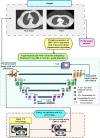Deep volcanic residual U-Net for nodal metastasis (Nmet) identification from lung cancer
- PMID: 38374909
- PMCID: PMC10874362
- DOI: 10.1007/s13534-023-00332-5
Deep volcanic residual U-Net for nodal metastasis (Nmet) identification from lung cancer
Abstract
Lymph node metastasis detections are more clinically significant task associated with the presence and reappearance of lung cancer. The development of the computer-assisted diagnostic approach has greatly supported the diagnosis of human disorders in the field of medicine including lung cancer. Lung cancer treatment is possible if it is detected at the initial stage. Radiologists have great difficulty identifying and categorizing lung cancers in the initial phase. So, several methods were used to predict the lung cancer but does not provide accurate solutions with increased error rate. To overcome these issues, a Deep Volcanic Residual U-Net (DVR U-Net) for nodal metastasis is proposed in this manuscript which identifies the LC accurately in the early stage. Initially, the input images are taken from two datasets. After that, these input data are pre-processed using Anisotropic Diffusion Filter with a Fuzzy based Contrast-Limited Adaptive Histogram Equalization (ADFFCLAHE) method. Then the pre-processed images are given to the DVR U-Net to segment and extract the volume of interest for estimating the nodal stage of each volume of interest. Finally, DVR U-Net effectively detects and classifies the N + (nodal metastasis) or N- (non-nodal metastasis). The introduced method attains 99.9% higher accuracy as compared with the existing methods. Also, the statistical analysis of the Shapiro-Wilk test, Friedman test and Wilcoxon Signed-Rank test are executed to prove the statistical effectiveness of the implemented method.
Keywords: Deep Residual U-Net; Lymph node metastasis identification; Node metastasis; Non-Node metastasis; Volcano eruption algorithm.
© Korean Society of Medical and Biological Engineering 2023. Springer Nature or its licensor (e.g. a society or other partner) holds exclusive rights to this article under a publishing agreement with the author(s) or other rightsholder(s); author self-archiving of the accepted manuscript version of this article is solely governed by the terms of such publishing agreement and applicable law.
Conflict of interest statement
Conflict of interestThe authors have no relevant financial or non-financial interests to disclose.
Figures








Similar articles
-
Multi-energy level fusion for nodal metastasis classification of primary lung tumor on dual energy CT using deep learning.Comput Biol Med. 2022 Feb;141:105185. doi: 10.1016/j.compbiomed.2021.105185. Epub 2021 Dec 29. Comput Biol Med. 2022. PMID: 34986453
-
Dual energy CT image prediction on primary tumor of lung cancer for nodal metastasis using deep learning.Comput Med Imaging Graph. 2021 Jul;91:101935. doi: 10.1016/j.compmedimag.2021.101935. Epub 2021 May 15. Comput Med Imaging Graph. 2021. PMID: 34090261
-
Convolutional neural network-based program to predict lymph node metastasis of non-small cell lung cancer using 18F-FDG PET.Ann Nucl Med. 2024 Jan;38(1):71-80. doi: 10.1007/s12149-023-01866-5. Epub 2023 Sep 27. Ann Nucl Med. 2024. PMID: 37755604
-
Significance of Lymph Node Metastasis in the Treatment of Gastric Cancer and Current Challenges in Determining the Extent of Metastasis.Front Oncol. 2022 Jan 7;11:806162. doi: 10.3389/fonc.2021.806162. eCollection 2021. Front Oncol. 2022. PMID: 35071010 Free PMC article. Review.
-
Minimizing residual occult nodal metastasis in NSCLC: recent advances, current status and controversies.Expert Rev Anticancer Ther. 2020 Feb;20(2):117-130. doi: 10.1080/14737140.2020.1723418. Epub 2020 Feb 5. Expert Rev Anticancer Ther. 2020. PMID: 32003589 Review.
Cited by
-
CT synthesis with deep learning for MR-only radiotherapy planning: a review.Biomed Eng Lett. 2024 Sep 26;14(6):1259-1278. doi: 10.1007/s13534-024-00430-y. eCollection 2024 Nov. Biomed Eng Lett. 2024. PMID: 39465111 Review.
-
A comprehensive review on Compton camera image reconstruction: from principles to AI innovations.Biomed Eng Lett. 2024 Sep 20;14(6):1175-1193. doi: 10.1007/s13534-024-00418-8. eCollection 2024 Nov. Biomed Eng Lett. 2024. PMID: 39465108 Free PMC article. Review.
References
-
- Kaya SI, Ozcelikay G, Mollarasouli F, Bakirhan NK, Ozkan SA. Recent achievements and challenges on nanomaterial based electrochemical biosensors for the detection of colon and lung cancer biomarkers. Sens Actuators B Chem. 2022;351:130856. doi: 10.1016/j.snb.2021.130856. - DOI
LinkOut - more resources
Full Text Sources
